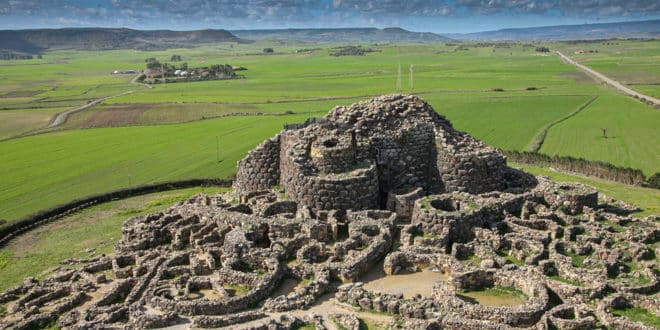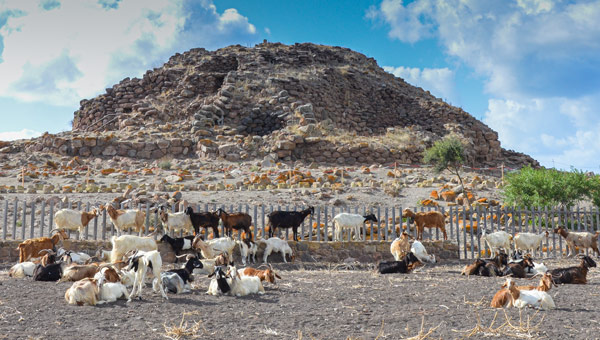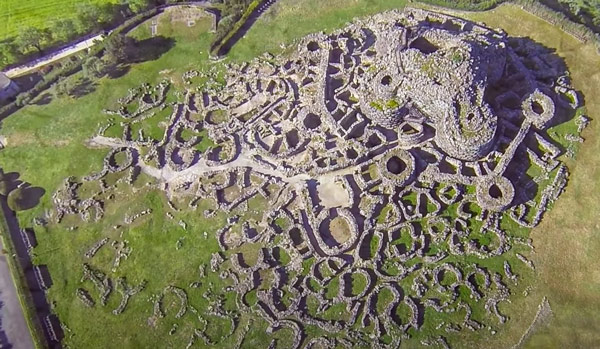Su Nuraxi di Barumini – an archaeological monument of prehistoric times located on the island of Sardinia, near the town of Barumini. It is a well-preserved complex of megalithic towers dating back to the 15th century BCE. For a long time, such ancient structures scattered across the island remained unnoticed by the scientific community.
Understanding the history and origins of Sardinian culture became possible inextricably linked to these ancient architectural monuments and the necessity of their preservation. In 1997, the unique Su Nuraxi site, the most prominent attraction in Sardinia, was included in the UNESCO World Heritage List.
Page Contents
The Emergence of Nuraghi in Sardinia
The name Su Nuraxi, translated from the Campidanese dialect of the Sardinian language, means “nuraghi” – the term used for prehistoric stone structures resembling towers, which were prevalent in Sardinia from the 2nd millennium BCE to the 13th century BCE. Su Nuraxi is not the only preserved architectural monument.
Currently, the island boasts around 800 nuraghi with varying degrees of preservation, and in the past, their numbers reached 20,000 to 30,000. Stone walls were erected around these towers, giving rise to settlements commonly referred to as Nuragic villages.
Debates about the people who brought the culture of constructing nuraghi and had their own unique language continue to this day. Most likely, they were migrants from the Eastern Mediterranean who possessed a higher level of development and introduced new knowledge in various aspects of the life of the island’s indigenous population. One of the most intriguing discoveries is the presence of enigmatic Etruscans during the construction period of the nuraghi, for whom Sardinia became a migratory stopover from Asia Minor to Italy.
Artifacts dating back to the Nuragic period do indeed resemble not only ancient findings from the Eastern Mediterranean but also bear a striking resemblance to Etruscan culture.
I recommend reading about:
- Etruscan necropolises in Cerveteri and Tarquinia.
- The Etruscan Museum at Villa Giulia in Rome.
- Cività di Bagnoregio – a city founded by the Etruscans.
Description and Purpose of Nuraghi
All nuraghi have a similar construction, consisting of a circular tower-like structure with a truncated top. The walls are remarkably thick, up to 3 meters, and are built from natural stone without any binding mortar. Some towers reach a height of 20 meters, and the entire structure is supported on the surface without foundation, maintaining stability due to its substantial mass, weighing several tons.
Typically, nuraghi were constructed on elevated terrain with good visibility, allowing for the control of all significant access routes.
The original purpose of these ancient structures remains a subject of debate to this day. They could have served a single function or multiple purposes – as military fortifications, temples, residences of rulers, or ordinary dwellings.
Nuraghi were used until the Roman invasion in the 2nd century BCE, although some sources suggest an even later period, as late as the 3rd century CE.
To better grasp the scale of these constructions, watch drone footage.
The Archaeological Complex near the Town of Barumini
Su Nuraxi di Barumini represents Sardinia’s most vivid and complete example of Nuragic architecture. The study of this ancient monument, after many years of obscurity, began only after World War II thanks to the initiative of archaeologist Giovanni Lilliu.
The complex, situated on the so-called Nuragic Hill (Bruncu Su Nuraxi), consists of several towers, walls, and an adjacent settlement.
Nuraghes
At the heart of this massive structure stands a three-level tower reaching a height of 18.6 meters, surrounded by four other towers, all precisely oriented to the cardinal points.
It is presumed that the main Nuraghe, constructed with basalt blocks, was built between the 17th and 15th centuries BCE and was intended for religious purposes or served as a meeting place for rulers.
The external ring consists of seven smaller towers connected by a suspended wall featuring seven battlements, although only five of these towers remain visible today. Remnants of the defensive function can be seen in the slits within the walls, which were later fortified with a three-meter layer of masonry to reinforce the ancient structure.
Accessing the inner courtyard and central tower from the outside was impossible. The entrance was situated high above the ground within the inner ring of towers. It is likely that rope ladders were used to enter the Nuraghe, which could be easily removed in times of danger.
Notably, there is a colossal well in the center of the inner courtyard of the complex, which still contains water. This well reaches a depth of 15 meters and mirrors the shape of the Nuraghe, widening to a diameter of 4 meters at the bottom and tapering toward the top.
The system of passageways and chambers within the Nuraghe constitutes a complex plan that could easily confuse an enemy and incite panic.
Nuragic Village
Between the 13th and 6th centuries BCE, structures began to emerge along the walls of the Su Nuraxi towers, forming a settlement that housed up to 1,000 residents.
Round huts with diameters of 5 to 6 meters were constructed from stone and featured conical roofs made of wood and branches. Their number varied from 40 to 200, serving as not only dwellings but also craft workshops, kitchens, places for prayers and gatherings, and centers for processing agricultural produce. By the 9th to 8th centuries BCE, sewage systems were already in place, along with paved squares and streets.
It’s intriguing to note that excavations of the Nuragic village did not reveal any signs of wealth inequality. The lack of precise information regarding the society and religion of ancient Sardinian people makes it difficult to explain their way of life. What is known is the prevalent worship of a fertility goddess, a common practice among all Mediterranean peoples who revered the Earth, water, and celestial bodies.
Abandonment and Decline
In the 6th century BCE, the settlement was destroyed and subsequently reconstructed by Carthage. Prior to its complete abandonment after the Roman occupation, Su Nuraxi was also used for storage and even burials. Gradually, the stone structures became covered with sedimentary rocks and turned into a hill until excavations and research on the ancient Nuraghes began in the 1950s.
How to Get There and Tickets
The archaeological complex (Area Archeologica “Su Nuraxi”) is located 65 km from Cagliari, and the drive takes about 1 hour by car. Here is the exact location on the map.
Adult tickets cost 14 euros. For teenagers aged 13 to 17, it’s 11 euros. For children aged 7 to 12, it’s 8 euros, and children under 6 years old can enter for free. Due to safety regulations, visits to the archaeological complex are possible only from the outside on rainy days.
Opening hours are from 9 a.m. to 4 p.m., and during the summer months, it’s open until 8 p.m. Visitors can enter a minimum of one hour before closing.
Official website: www.fondazionebarumini.it
 Italy for me From Italy with love
Italy for me From Italy with love






